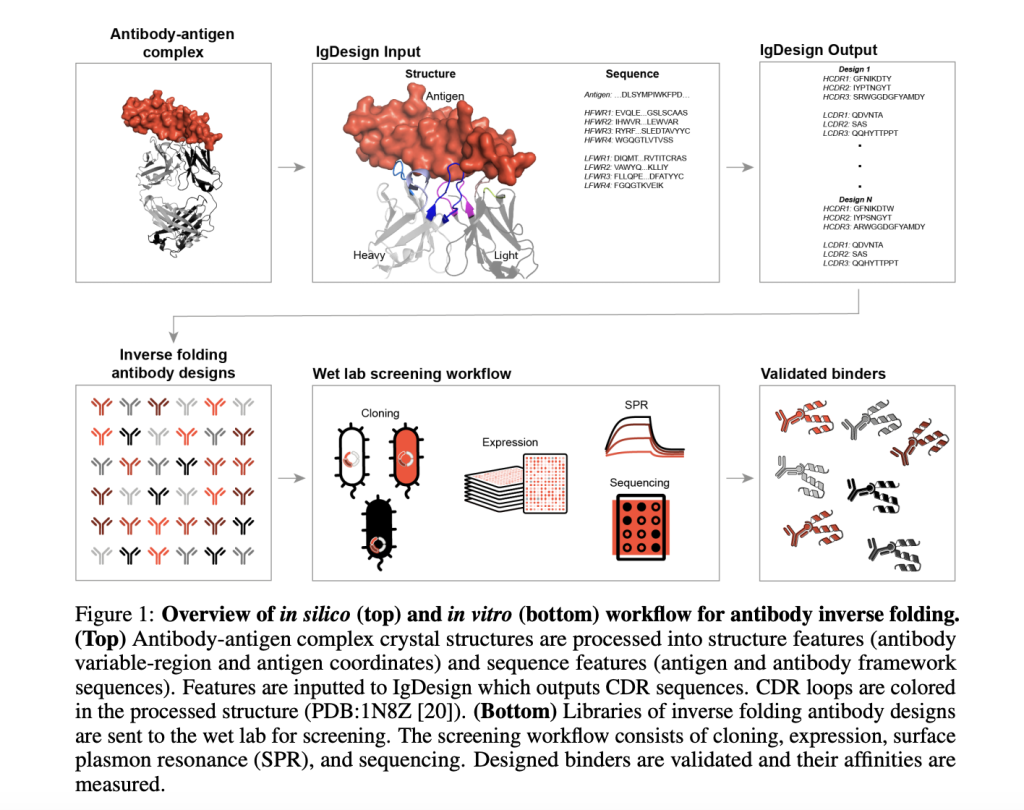

Designing antibodies with high specificity and binding affinity to diverse therapeutic antigens remains a significant challenge in drug development. Current methods struggle to effectively generate complementarity-determining regions (CDRs) responsible for antigen binding, especially the highly variable heavy chain CDR3 (HCDR3). These difficulties are mainly due to poor generalization of the already existing computational models to the experimental validation of their designs, inefficiency in optimizing leads, etc. Addressing these challenges will drive the advancement of therapeutic antibody engineering to advance and accelerate the formulation of effective treatments.
The current computational models, like ProteinMPNN and AntiFold, use generative approaches to predict sequences that fit particular antibody structures. Although these systems have excellent in silico performance, their practical application is limited by the absence of extensive experimental validation. Additionally, they suffer from designing several CDR regions as a coherent approach toward attaining antigen specificity. They greatly require curated datasets, which are real constraints on their ability to scale to new targets-antigens and prove inadequate in performance aspects compared to baselines set up.
Absci Bio Releases IgDesign: A Deep Learning Approach Transforming Antibody Design with Inverse Folding. IgDesign addresses the above limitations through a novel generative framework tailored to antibody design. It incorporates contextual inputs such as antigen sequences and antibody framework (FWR) sequences to create optimized CDR3 (HCDR3) and complete heavy-chain CDRs (HCDR123). Structure-aware encoder and sequence decoder, inspired by LM-design but specially adapted for antibody functions. It further distinguishes itself by the ability to design high-affinity binders validated through extensive in vitro testing across eight therapeutic antigens. The breakthrough enhances scalability, improves generalizability, and achieves experimental success rates that set a new standard for therapeutic antibody design.
The researchers curated datasets from SAbDab and PDB, ensuring the inclusion of strong antigen-specific holdouts to eliminate the possibility of data leakage. The model was pre-trained on a general protein dataset and then fine-tuned on antibody-antigen complexes. Antibody sequences were generated sequentially to maintain coherence between interdependencies of regions; for each antigen, 100 HCDR3 and 100 HCDR123 were generated and tested. The sequences were progressed through an extensive wet-laboratory protocol that included cloning of the sequences into E. coli, expression within these cells, and high throughput SPR screening designed to support the confirmation of binding kinetics and affinities. A robust set of HCDR3 sequences from the training dataset was used as controls to measure performance, a distinct reference point for proving the utility of IgDesign.
IgDesign showed consistent superior performance of designed antibodies across all different antigens. Experiments in vitro showed that designs of HCDR3 had significantly higher binding rates than baselines for seven out of eight tested antigens, and the design of HCDR123 outperformed the baseline for four of them. The produced antibodies are bound at affinities close to or better than those of clinically validated reference antibodies for targets such as CD40 and ACVR2B. Such findings underline the potential of IgDesign to generalize proficiently and design superior antibodies, which opens up transformative possibilities in therapeutic antibody development.
This work represents a significant step for antibody design in that IgDesign marries high computational accuracy with empirical evidence to create a unified, streamlined process. As a result of success in antigen-specific binder construction exhibiting very high affinity, this advance challenges major bottlenecks in drug discovery. The framework not only facilitates lead optimization but also paves the way for de novo antibody design, significantly advancing the field of drug discovery.
Check out the Paper and Code. All credit for this research goes to the researchers of this project. Also, don’t forget to follow us on Twitter and join our Telegram Channel and LinkedIn Group. Don’t Forget to join our 60k+ ML SubReddit.
The post Absci Bio Releases IgDesign: A Deep Learning Approach Transforming Antibody Design with Inverse Folding appeared first on MarkTechPost.
Source: Read MoreÂ

 Trending: LG AI Research Releases EXAONE 3.5: Three Open-Source Bilingual Frontier AI-level Models Delivering Unmatched Instruction Following and Long Context Understanding for Global Leadership in Generative AI Excellence….
Trending: LG AI Research Releases EXAONE 3.5: Three Open-Source Bilingual Frontier AI-level Models Delivering Unmatched Instruction Following and Long Context Understanding for Global Leadership in Generative AI Excellence….